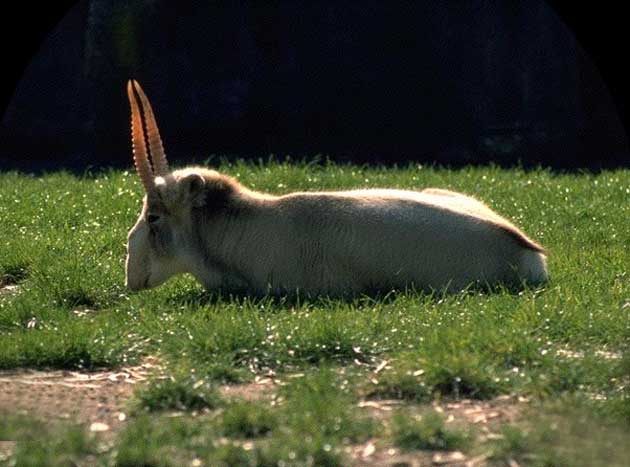- Saiga Antelope
Taxobox
name = Saiga
status = CR
status_system = iucn3.1

image_caption = Male Saiga ("Saiga tatarica")
image_width = 250px
regnum =Animal ia
phylum = Chordata
classis =Mammalia
ordo =Artiodactyla
familia =Bovidae
subfamilia =Antilopinae
genus = "Saiga"
species = "S. tatarica"
binomial = "Saiga tatarica"
binomial_authority = (Linnaeus , 1766)The Saiga ("Saiga tatarica") is an
antelope which originally inhabited a vast area of theEurasia nsteppe zone from the foothils of the Carpathians andCaucasus intoDzungaria andMongolia . Today they are found only in a few areas inKalmykia (Russia),Kazakhstan , and westernMongolia .Physical characteristics
The Saiga typically stands 0.6-0.8 meters at the shoulder and weighs between 36 and 63 kg. Their lifespan ranges from 6 to 10 years. Males are bigger than females and are the only sex to carry horns. The horns have some value as Chinese traditional medicine and for that reason Saiga are now endangered by poaching. The Saiga is recognizable by an extremely unusual, over-sized, and flexible, nose structure. The nose is supposed to warm up the air in winter and filters out the dust in summer.
Habitat and behavior
Saigas form very large herds that graze in semi-desert steppes eating several species of plants, including some that are poisonous to other animals. They can cover considerable distances and swim across rivers, but they avoid steep or rugged areas. The mating season starts in November, when stags fight for the possession of females. The winner leads a herd of 5-50 females. In springtime the mother gives birth to, in two thirds of all cases two, or in one third, one single foal.
Distribution
During the
Ice Age the Saiga occurred from theBritish Isles throughCentral Asia and theBering Strait intoAlaska and theYukon . At the beginning of the 18th century it was still distributed from the shores of theBlack Sea , the Carpathian foothills and the northern edge of the Caucasus intoDzungaria and Mongolia. After a rapid decline they were nearly completely exterminated in the 1920's, but they were able to recover and by 1950 there where again two million of them in the steppes of the USSR. At one point, some conservation groups, such as theWorld Wildlife Fund , encouraged the hunting of this species as its horn was presented as an alternative to that of arhinoceros . cite book| last = Ellis| first = Richard| authorlink = Richard Ellis (biologist) | title = No Turning Back: The Life and Death of Animal Species| publisher = Harper Perennial | date = 2004| location = New York| pages = 210| isbn =0-06-055804-0 ] Today the populations have again shrunk enormously and the Saiga is classified as critically endangered by the IUCN. There is an estimated total number of 50,000 Saigas today, which live in Kalmykia, three areas ofKazakhstan and in two isolated areas of Mongolia.Cherny Zemli Nature Reserve was created in Russia's Kalmykia Republic in 1990s to protect the local saiga population. The populations of Mongolia represent a distinct subspecies, theMongolian Saiga ("Saiga tatarica mongolica"), with 750 individuals. All other populations, belong to the nominal subspecies "Saiga tatarica tatarica".Currently only the Moscow and Cologne zoos keep saigas.
San Diego Zoo has had them in the past.Pleistocene Park in northern Siberia plans to introduce the species.References
* [http://www.ultimateungulate.com/Artiodactyla/Saiga_tatarica.html Ultimate Ungulate]
External links
* [http://www.cms.int/species/saiga/saiga_meetings.htm CMS Saiga Memorandum of Understanding]
*ARKive - [http://www.arkive.org/species/GES/mammals/Saiga_tatarica/ images and movies of the Saiga antelope "(Saiga tatarica)"]
* [http://saigak.biodiversity.ru/ Information Support of Saiga Preservation Programs] ru icon
* [http://www.cic-wildlife.org/?id=157 CIC - International Council for Game and Wildlife Conservation]
* [http://www.saiga-conservation.com Saiga Conservation Alliance]
Wikimedia Foundation. 2010.
